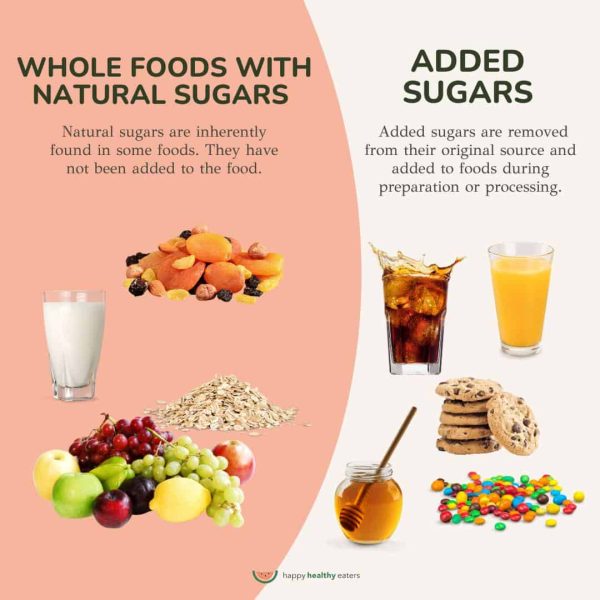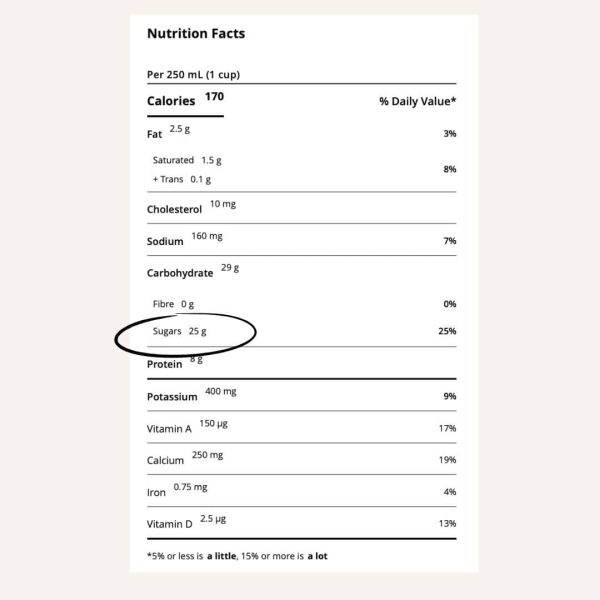Sugar. It’s the sweet stuff that many of us enjoy, and the taste young kids often have an affinity for. In the land of cereals, snack foods, and yogurts, it can get pretty overwhelming to sort through the best choice for you and your family, which is inherently going to vary from household to household.
Now listen – the aim of this blog post isn’t to entice you to eat more sugar. It’s also not intended to leave you worried about sugar. And we’re certainly not about to shout false fear mongering messages about it being toxic. Instead, it’s to educate you about common questions parents have when it comes to the sweet stuff so you can make informed choices when shopping.
Before we get into it, there’s one more thing you should know.
As Registered Dietitians, moms, and food enthusiasts we philosophically believe all foods can fit. We also believe that a positive relationship with food, all food, is worth pursuing so that we (and our kids) can enjoy a variety of foods, including a birthday cake or bowl of ice cream, without the guilt, shame, or worry we’ve done something “wrong” or “bad” to our body. And in the same breath, we believe that structure, enjoying a variety of foods, and recommendations to limit sugar are also important for optimising health and nurturing a positive relationship with food as previously alluded to.
It’s a more nuanced and complicated approach, which can feel uncomfortable sometimes. As humans we gravitate towards “in the box” or “out of the box” thinking. It’s more settling to definitively know whether you’re in the right or in the wrong.
Without further adieu, let’s get into sugar!
Why is it a good idea to know if a food contains added sugar?
There are a few reasons that come to mind:
First, being aware of the presence of added sugars in common foods can be helpful for parents of babies and toddlers because excessive sugar intake can displace essential nutrients. During the critical developmental window of ages zero to three, children have heightened nutrient needs to support their rapid growth and brain development. Foods high in added sugars can take up precious room in those little tummies quickly, leaving less room for nutrient-dense foods such as fruits, vegetables, whole grains, and protein-focused foods. Simply put, there just isn’t a ton of wiggle room.
Secondly, being “in the know” about added sugars helps parents make informed purchasing decisions and be able to draw comparisons between similar products. Food is an expense (and boyyyy is it extra expensive right now, inflation anyone?). Personally, we want to know what we’re spending our hard earned money on and there’s a good chance you do too.
Lastly, reducing the amount of sugar in core foods (yogurt, baked goods, bars etc) can help lower a child’s “bliss point” – the level of sweetness at which food is most enjoyable. When children are accustomed to less sugary foods, occasional sweet treats remain special and satisfying without contributing to a preference for overly sugary foods.
Suggested reading: Babies, sweets, and sugar: the complete 411
Naturally occurring sugars, added sugars, free sugars, what’s the difference?
If you’ve done even a bit of research on the topic of sugar, you might be confused about what’s what and what even matters? To help, let’s take a look at the difference between naturally occurring sugars and added sugars (also known as free sugars).
Foods that contain natural sugars, like lactose in cow’s and human milk and fructose in fruit, come as nature intended, with these sugars inherently present. Nobody added the “sugar” into cow’s milk at the dairy plant.
Added sugars, on the other hand, refers to concentrated sources of sugar such as: honey, table sugar, maple syrup, coconut sugar, and and fruit juice concentrate. Free sugars is another term used for added sugars + 100% fruit juice.
Added (or free) sugars are what you typically find in baking, candy, soda, sugary beverages, flavoured yogurt, sweetened cereals, some pasta sauces, some condiments like ketchup and BBQ sauce, plant-based beverages, and most chocolate milk! You see, a form of sugar is added to the product.

How much added sugar is okay?
When it comes to added sugar, there’s no minimum amount you should eat. Sugar isn’t an essential nutrient we need to eat. For our youngest of eaters under age 2, the most current recommendation is to completely avoid added sugars.
But that’s such a long time to hold out, why?
Sugar can take the place of other important foods and nutrients that babies and young toddlers need to grow and develop. When researchers evaluate childhood needs, there just isn’t a lot of wiggle room given their heightened energy and nutrient requirements.
So, your child is older than 2, now what?
The World Health Organization offers a recommended daily limit to keep free sugar (aka added sugars + 100% fruit juice) to less than 5-10% of a child’s caloric intake. For a 2 to 3 year old that needs about 1200 kcal, that’s about 15g to 30g of sugar.
For context, 1 tbsp of sugar is about 12.5g.
You might be wondering, what about natural sugars found in whole foods such as milk or fruit? There’s no recommendation or need to limit these foods per se because they offer a host of benefits and do not negatively impact health outcomes. Of course…you probably don’t want to exclusively offer your child milk and fruit because like anything, variety is important!
Do you need a visual representation of this? Check out this Instagram post where we showcase what a typical day of eating can look like for your child without exceeding the sugar recommendation.
How to spot added sugars in ingredient list
First, a little primer on ingredient lists is in order! (haha, did you see what I did there?). The order of the ingredients is neither random nor alphabetical. Manufacturers have to list the ingredients in descending order from the largest quantity (by weight) to lowest quantity.
Since many people have become savvy in looking for sources of sugar in the first few ingredients, manufacturers started using a mix of different sugars so that they’d all show up lower down on the list. At least – that’s the cynical take on the situation. The optimistic take would be simply that certain recipes might benefit from different sources of sugar!
Regardless of whether you’re cynical or optimistic, Health Canada wanted to make it easier on consumers to spot sugars. So, a new labelling rule recently came into place. Manufacturers are now required to group together all sources of sugar.
Let’s look at a very simplified example (please note: this is not a real recipe!).
If a recipe called for wheat flour (35%), vegetable oil (25%), agave (15%), dextrose (15%), honey (10%), with the old rules, the ingredient list would look like this:
Ingredients: wheat flour, vegetable oil, agave, dextrose, honey
As you’re grocery shopping with a crying baby in the carrier and a toddler asking every five seconds “can we get this? can we get that?,” you might quickly glance at the ingredient list, look at the first couple of ingredients and think “oh good, sugar is lower down on the list -it probably isn’t very high in added sugars!” … especially if you’re unfamiliar with forms of sugar such as agave and dextrose and think honey is the only sweetener.
However, using the new rules, if you add all those three sweeteners together you get an ingredient list that looks like this:
Ingredients: sugars (agave, dextrose, honey), wheat flour, vegetable oil
Now, if you took a quick glance at the ingredient list, you’d see sugars listed first and learn that agave and dextrose are sweeteners!
Speaking of obscure sources of sugar, it can also be helpful to familiarize yourself with some of these names. If it’s the only sweetener in a food product then it can be listed by its name instead of under a grouping of sugars.
- ___ sugar
- Example: coconut sugar
- Ingredients ending in -ose
- Example: glucose-fructose
- Fruit or fruit juice concentrates
- Example: pear juice concentrate
- Syrups
- Honey, agave, molasses, maltodextrin

How to spot added sugars in nutrition facts
If you live in the United States, you’re in luck because the quantity of added sugars needs to be shown as a sub-point under the total sugars. Take a look at this American label for chocolate milk.

As you can see, there’s a total amount of sugar but only some of the sugar is added in. That’s because milk naturally contains a sugar called lactose. And remember – there’s no research to show that sugar found in whole foods such as dairy and fruit has any ill- health effects.
Now, when you look at a label for chocolate milk in Canada, this is what you’ll find:

Both the naturally occurring and added sugars are lumped together.
Health Canada decided to focus on the % Daily Value for total sugars. As with all % Daily Value figures, it can be useful to use the 5%-15% rule. If the serving has more than 15% of total sugars, it likely has a higher amount of added sugars.
Finding that elusive balance
Feeding kids is very nuanced. It’s striking a balance between making sure they get the nutrition they need to grow and thrive while also not creating a scarcity mindset around some of the foods they may be more drawn to but offer less nutrition.
One way we strive for this balance is to be mindful of keeping our family’s core foods lower in sugar so that there’s room in the “sugar bank,” so to speak; and we can allow our kids to enjoy their candy without worrying that it’s taking the place of essential nutrients.
We hope that you can take this information and use it to empower you while also helping you relax about feeding your kids!






